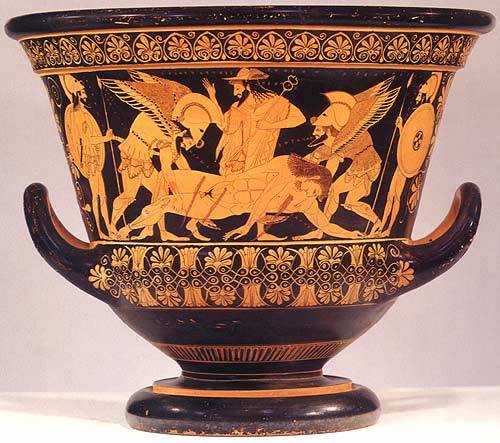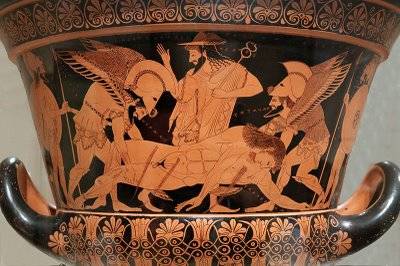Hot Pot Stirs up Sizzling Debate
ROME – Culture sneaks onto the agenda when least one might expect it. In a leaked tape recording of a private conversation, Premier Silvio Berlusconi revealed to a female acquaintance, the professional escort Patrizia D’Addario, that “thirty Phoenician tombs from 300 BC” had been discovered on his property near Olbia in Sardinia.
The political opposition to the center-right government has raised a question in Parliament because under Italian law all such findings are automatically state property, and any discovery of archaeological sites must be formally declared to the authorities. Was this?
Questioned on this by Corriere della Sera today, archaeologist Andrea Carandini, who heads the scholarly board of counsellors for the Cultural Heritage Ministry, hypothesized, “I am sure that he [the Premier] will have declared them to the local superintendency.”
However, a statement by the National Association of Archeologists suggested otherwise: “If confirmed, this represents an important finding for the study of Phoenician expansion throughout the island, completely unknown to the scientific community”
The scholarly issue is important because until now the Olbia area had been considered founded by overseas Greeks. Since no large necropolis exists without a nearby township, the new findings of Phoenician origin would change history, literally.
Elsewhere the Euphronios kalyx krater—that’s the one former Metropolitan Museum director Thomas Hoving dubbed the “hot pot”—continues to stir up a sizzling debate in Italy.
This exquisite krater showing the death of the warrior Sarpedon is the Sistine Chapel of Greek pots, an unexcelled masterpiece. It was made by the potter Euxitheos and painted and signed by Euphronios, leader of the group of artists who transformed black-figure vase painting to the far more sophisticated red-figure during the golden age of Athens in the early Sixth Century BC.
The vase, as was suspected even in 1972, was stolen from a tomb at the ancient Etruscan site of Cerveteri, on the seacoast due north of Rome. It was illegally marketed to the Met by Robert Hecht, today an octegenarian, who is still on trial in Rome along with the Getty Museum’s former curator Marion True. Although Hecht claimed the pot had come from Beirut, in all likelihood he received it from the local Giacomo Medici, whose conviction for trafficking in looted objects was upheld July 15 by a Rome appeals court. (The court dropped his sentence from to eight years in prison, and he is free pending appeal to the Cassations Court, Italy’s highest.)
In his book Making the Mummies Dance (Simon & Schuster, 1993) Hoving admitted to feeling a “near-sexual pleasure” when the million dollar purchase on behalf of the Met was concluded in 1972, “just underneath the crack in the door of the pending UNESCO treaty which would drastically limit the trade in antiquities.”
Today the hot pot is back in Italy, returned with apologies from the Met, with fanfare, and placed briefly on exhibition in the Quirinal Palace before being put on permanent view in the Etruscan Museum at Villa Giulia in Villa Borghese in Rome. This venue was chosen because the Villa Giulia museum houses all the greatest treasures of Etruria in Italy, and particularly from tiny Cerveteri.
However, grumbling from American art lovers has followed. “I used to be able to walk ten minutes and see it,” moaned one disappointed New Yorker. Writing for the New York Times, Michael Kimmelman observed, “Italians don’t seem to care” about the treasure in their presence—that is, they care less than the New Yorkers do. The implication is that restitution was a mistake; that the krater was basically better off in New York, and that the Euphronios is just one more pot, hot or cool, in Italy, blessed with so much stuff that it does not know where to look first, or bother to look. Besides, as another serious academic observed, in Italy it is hard to find out where things are in the museums.
Reacting to the criticism in the New York Times, Culture Minister Sandro Bondi proposed that the hot pot be taken on a “road show” (his words) throughout Italy.
Bondi’s opponents (one of them, anyway) seem to agree. Speaking at a conference on cultural property held in Rome in mid-July, Bondi’s predecessor as minister and political rival from the center-left, Francesco Rutelli, who also happens to be a former mayor of Rome, blamed the present government for failing to have given sufficient publicity and air space to the objects repatriated so far from not only the Met, but from the Boston Fine Arts Museum, the Cleveland Museum of Art and the Getty in Malibu.
In this context, the Culture Ministry has formalized creation of an office that will promote “valorizzazione” (public fruition) of the cultural heritage—that is, make the object more visible, more profitable to the Ministry and museums, currently underfunded because of current government reductions in the ministry budget.
In other words, both present and former culture ministers are in basic agreement with the critics in the U.S.—that publicity (that “road show”) is the way forward, and that the beni culturali can be profitable businesses. Not surprisingly, one Italian citizen, Paola Lucia, has proposed renting out the Euphronios vase.
At this point the distinguished archaeologist Prof. Salvatore Settis, director of the Scuola Normale Superiore at Pisa, Carandini’s predecessor as head of the Culture Ministry’s oversight board, weighed in. Writing in the daily La Repubblica July 23, Settis pointed out that the restitution of the hot pot and similar looted artifacts is based upon “the intrinsic nature of the public worth of the objects, and on their pertinence within an indivisible context linked to the place where they were found.” Renting cultural property to a foreign institution, Settis went on to say, would alter the very principle upon which the restitution was made, since the the return of an object would be requested in order to commercialize it—and in future no museum would dream of returning objects looted from Italy.
The Euphronios krater goes on view from September 22 through January 30, 2010, in Castel Sant'Angelo in Rome together with fifty-nine other objects recovered through the work of the Carabinieri Fine Arts squad, the Comando Tutela Patrimonio Culturale, celebrating its fortieth year of activity. Besides the "hot pot," on exhibit are the ancient Roman group of the Capitoline Triad of gods (the only known examplar), Raphael's "Portrait of a Gentleman" and paintings by Bellini, Van Gogh, Renoir and Cezanne.









































i-Italy
Facebook
Google+
This work may not be reproduced, in whole or in part, without prior written permission.
Questo lavoro non può essere riprodotto, in tutto o in parte, senza permesso scritto.